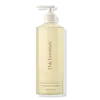What's inside
What's inside
 Key Ingredients
Key Ingredients

 Benefits
Benefits

 Concerns
Concerns

 Ingredients Side-by-side
Ingredients Side-by-side

Water
Skin ConditioningCocamidopropyl Hydroxysultaine
CleansingSodium Cocoyl Glutamate
CleansingSodium Cocoamphoacetate
CleansingLauryl Glucoside
CleansingGlycerin
HumectantCitric Acid
BufferingSodium Lauryl Glucose Carboxylate
CleansingGlyceryl Oleate
EmollientCoco-Glucoside
CleansingTriethyl Citrate
MaskingTetrasodium Glutamate Diacetate
Lavandula Hybrida Oil
EmollientJuniperus Virginiana Oil
MaskingBoswellia Serrata Gum
MaskingAbies Balsamea Needle Oil
MaskingNiacinamide
SmoothingOryza Sativa Bran Extract
Skin ConditioningVetiveria Zizanoides Root Extract
PerfumingPogostemon Cablin Leaf Oil
MaskingJuniperus Mexicana Oil
MaskingBulnesia Sarmientoi Wood Oil
MaskingHelianthus Annuus Extract
EmollientRosmarinus Officinalis Extract
AntimicrobialHydrogenated Palm Glycerides Citrate
EmollientTetrahexyldecyl Ascorbate
AntioxidantPotassium Sorbate
PreservativeTocopherol
AntioxidantLinalyl Acetate
MaskingSodium Chloride
MaskingSodium Benzoate
MaskingLimonene
PerfumingLinalool
PerfumingWater, Cocamidopropyl Hydroxysultaine, Sodium Cocoyl Glutamate, Sodium Cocoamphoacetate, Lauryl Glucoside, Glycerin, Citric Acid, Sodium Lauryl Glucose Carboxylate, Glyceryl Oleate, Coco-Glucoside, Triethyl Citrate, Tetrasodium Glutamate Diacetate, Lavandula Hybrida Oil, Juniperus Virginiana Oil, Boswellia Serrata Gum, Abies Balsamea Needle Oil, Niacinamide, Oryza Sativa Bran Extract, Vetiveria Zizanoides Root Extract, Pogostemon Cablin Leaf Oil, Juniperus Mexicana Oil, Bulnesia Sarmientoi Wood Oil, Helianthus Annuus Extract, Rosmarinus Officinalis Extract, Hydrogenated Palm Glycerides Citrate, Tetrahexyldecyl Ascorbate, Potassium Sorbate, Tocopherol, Linalyl Acetate, Sodium Chloride, Sodium Benzoate, Limonene, Linalool
Laureth-4
EmulsifyingMipa-Laureth Sulfate
CleansingPropylene Glycol
HumectantPrunus Amygdalus Dulcis Oil
Skin ConditioningRicinus Communis Seed Oil
MaskingCaprylic/Capric Triglyceride
MaskingPrunus Armeniaca Kernel Oil
MaskingTocopheryl Acetate
AntioxidantLaureth-3
EmulsifyingGlycerin
HumectantLactic Acid
BufferingLavandula Angustifolia Oil
MaskingSalvia Sclarea Oil
MaskingLinalool
PerfumingLimonene
PerfumingGeraniol
PerfumingIngredients Explained
These ingredients are found in both products.
Ingredients higher up in an ingredient list are typically present in a larger amount.
Glycerin is already naturally found in your skin. It helps moisturize and protect your skin.
A study from 2016 found glycerin to be more effective as a humectant than AHAs and hyaluronic acid.
As a humectant, it helps the skin stay hydrated by pulling moisture to your skin. The low molecular weight of glycerin allows it to pull moisture into the deeper layers of your skin.
Hydrated skin improves your skin barrier; Your skin barrier helps protect against irritants and bacteria.
Glycerin has also been found to have antimicrobial and antiviral properties. Due to these properties, glycerin is often used in wound and burn treatments.
In cosmetics, glycerin is usually derived from plants such as soybean or palm. However, it can also be sourced from animals, such as tallow or animal fat.
This ingredient is organic, colorless, odorless, and non-toxic.
Glycerin is the name for this ingredient in American English. British English uses Glycerol/Glycerine.
Learn more about GlycerinLimonene is a fragrance that adds scent and taste to a formulation.
It's found in the peel oil of citrus fruits and other plants such as lavender and eucalyptus. The scent of limonene is generally described as "sweet citrus".
Limonene acts as an antioxidant, meaning it helps neutralize free radicals.
When exposed to air, oxidized limonene may sensitize the skin. Because of this, limonene is often avoided by people with sensitive skin.
The term 'fragrance' is not regulated in many countries. In many cases, it is up to the brand to define this term. For instance, many brands choose to label themselves as "fragrance-free" because they are not using synthetic fragrances. However, their products may still contain ingredients such as essential oils that are considered a fragrance.
Learn more about LimoneneLinalool is a fragrance and helps add scent to products. It's derived from common plants such as cinnamon, mint, citrus, and lavender.
Like Limonene, this ingredient oxidizes when exposed to air. Oxidized linalool can cause allergies and skin sensitivity.
This ingredient has a scent that is floral, spicy tropical, and citrus-like.
Learn more about Linalool